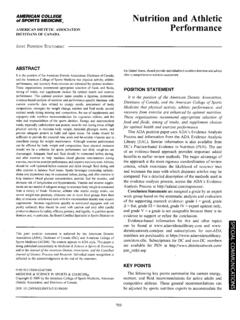Transcription of An Introduction to Varieties of Capitalism - UFJF
1 1An Introduction to Varieties of Capitalism Peter A. Hall and David Soskice _____ Political economists have long been interested in institutional variation across countries. Some regard the institutional differences among nations as deviations from best practice that can be expected to decline as countries catch up to the technological and organizational leader. Others see them as the distillation of more durable historical choices for a particular kind of economy and society, since economic institutions are closely linked to the levels of social protection, distribution of income, and collective goods that reflect a nation s conception of social solidarity. From either perspective, comparative political economy requires conceptual frameworks for identifying and understanding the most important variations in institutions across nations.
2 On such frameworks hang the answers to a range of important questions. Some of these are policy-related. What kinds of macroeconomic, industrial or social policies will improve the performance of the economy? What should governments be expected to do in the face of economic challenges and what defines a state s capabilities? Others are firm-related. Are there systematic differences in the structure and strategy of companies located in different countries and, if so, what conditions them? How are cross-national differences in the character of innovation to be explained? Institutional differences also affect economic performance. Do some forms of economic organization provide lower rates of inflation and unemployment or higher rates of growth?
3 What are the economic trade-offs to developing one type of political economy rather than another? Finally, there are second-order questions about institutional change and stability of special importance today. Can we expect the institutional structures of national economies to converge with technological progress and the competitive pressures associated with globalization ? What factors condition the adjustment paths taken by national political economies? The object of this book is to elaborate a new framework for understanding the differences and similarities among the developed economies that bear on such 2We outline the basic approach in this Introduction , while subsequent chapters extend and apply it to a wide range of economic and political issues.
4 It will be obvious that this approach is a work-in-progress, offering answers to some of these questions but generating new ones as well. As any work on this topic must be, ours is deeply-indebted to prior scholarship on the subject. The Varieties of Capitalism approach developed here can be seen as an effort to go beyond three perspectives on institutional variation that have dominated the study of comparative Capitalism for the past thirty years. 2 In important respects, each was a response to the economic problems of its time. The first of these perspectives was an interventionist approach to comparative Capitalism with roots in Shonfield s magisterial treatise of 1965.
5 Devised in the post-war decades, it saw the principal challenge confronting the developed economies as one of modernizing industries still dominated by pre-war practices in order to secure high rates of national growth. Analysts tried to identify a set of actors with the strategic capacity to devise plans for industry and to impress them on specific sectors. Occasionally, this was said to reside in the banks but more often in public officials. Accordingly, this approach emphasized the institutional structures that gave states leverage over the private sector, such as planning systems and public influence over the flows of funds in the financial system (Cohen 1977; Estrin and Holmes 1983; Zysman 1984; Cox 1986).
6 Countries were often categorized according to the structure of their state, into those with strong and weak states (Katzenstein 1978; Sachs 1980; Nordlinger 1981; Skocpol et al. 1985). From this perspective, France and Japan emerged as models of economic success and Britain as a laggard (Shonfield 1965; Johnson 1982). During the 1970s, however, when inflation seemed to be the preeminent problem facing the developed economies, a second approach to comparative Capitalism was developed, based on the concept of neo-corporatism (Schmitter and Lehmbruch 1978; Berger 1982; Goldthorpe 1984; Alvarez et al. 1991). Although there is some variation in how it is defined, neo-corporatism was generally associated with the capacity of the trade union movement to strike bargains of national significance with employers and the This capacity was usually said to depend on the centralization or concentration of the 3union movement, on an Olsonian logic of collective action which specifies that more encompassing trade unions can better internalize the economic effects of their wage settlements, (Olson 1965; Cameron 1984; Calmfors and Driffill 1988; Golden 1993).
7 Those who saw neo-corporatist bargains as a political exchange also emphasized the ability of states to offer inducements as well as the capacity of unions to discipline their members (Pizzorno 1978; Regini 1984; Scharpf 1984, 1988; cf. Przeworski and Wallerstein 1982). From this perspective, countries were categorized largely by reference to the organization of their trade union movement; and the small, open economies of northern Europe appeared as success stories in this literature. During the 1980s and 1990s, what we will term a social systems of production approach to comparative Capitalism gained currency. Under this rubric, we group a diverse set of analyses of sectoral governance, national innovation systems, and flexible production regimes united by several features.
8 Responding to the acceleration of technological change and reorganization of production apparent in this period, these works devote more attention to the needs of firms and, influenced by the French regulation school, all emphasize the way in which the institutional structures of a nation, region, or sector provide support for innovation and production regimes different from those traditionally associated with mass production (Boyer 1990; Piore and Sabel 1984; Herrigel 1995; Campbell et al. 1991; Hollingsworth et al. 1994; Hollingsworth and Boyer 1997; Streeck and Schmitter 1986; Dosi et al. 1988; Nelson 1993; Edqvist 1997). This literature brings a wider array of institutional structures into the analysis, many of them located at the sectoral or regional level, and often adopts a more sociological approach to institutions, stressing the ways in which they create trust or capacities for learning within economic communities.
9 As a result, it tends to resist the categorization of nations in favor of more emphasis on regional or sectoral particularisms whose models of success lie in dynamic regions like those of Baden-Wurttemberg and the Third Italy. Each of these bodies of work explains important aspects of the economic world. However, we seek to go beyond them in several respects. Although it characterized national differences in the era of modernization well, the interventionist approach overstates what governments can accomplish, especially in 4contexts of economic openness where adjustment is often firm-led. We will argue that features of states once seen as attributes of strength actually make the implementation of many economies policies more difficult; and we seek a basis for comparison more deeply-rooted in the organization of the private sector.
10 Neo-corporatist analysis directs our attention to the organization of society, but its emphasis on the organization of the trade union movement underplays the role that firms and employer organizations play in the coordination of the economy (cf. Soskice 1990a; Swenson 1991). We want to bring firms back into the center of the analysis of comparative Capitalism and, without neglecting trade unions, highlight the role of business associations as key collective actors in the political economy. In some respects, the literature on social systems of production does this, linking the organization of production to the support provided by institutions external to the firm.















